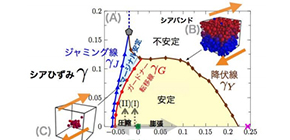
Adventures in Phase Space: Unified Map on Plastic and Elastic Glasses
Osaka University-led researchers simulate the phase diagram of a simple glass, showing how its plasticity, elasticity, yielding and jamming depend on the annealing process
Glasses are an enigma among solid phases. Like crystalline solids they are hard, but unlike crystals they are amorphous on the molecular scale. Because of this structural disorder, each piece of glass is technically out of equilibrium, and unique. As a result, its properties depend not only on its chemical ingredients, but on how it was cooled.
Their amorphousness makes it tricky to describe glasses with a general model. Now, however, a team led by Osaka University has used simulations to connect the annealing (cooling or compression) of a glass with its mechanical response to strain. In particular, their study – published in Science Advances – focused on two key metrics of solid behavior, elasticity and plasticity.
When deformed by shear strain, an “elastic” solid returns to its original shape after the strain is released. Plastics, in contrast, permanently retain their new shape. This contrast between “reversible” and “irreversible” changes has implications for how materials respond to mechanical forces – in the body, in technical applications, and even on the geological scale.
“We modeled dense assembly of colloids—a type of amorphous solid—made of hard spheres,” says study co-author Hajime Yoshino. “The spheres don’t represent real molecules, but they do show whether such dense glasses are elastic. We simulated how they responded to shear and normal strains. Our large supercomputers fully mapped out the strain phase-diagrams of glass formers for the first time, to explore their rheology.”
Each glass showed four basic trends. Under small strains they were perfectly elastic. At higher strains they became partially plastic, failing to recover the original state when the deformation was partly lifted. Eventually they face either of the two opposite fates at larger strains: total failure by fracturing (yielding) to release stress, or complete stop by jamming (becoming congested). The region between yielding and jamming on the phase diagram defined where the original glass remained stable.
“We can understand the responses as those of stable, partly stable and unstable glasses,” explains lead author Yuliang Jin. “Interestingly, the size of the solid region—and its stable sub-zone—depends on how well the glass was annealed. Better annealed glasses have larger chances of jamming under shear. Our work is the first to demonstrate that ultimate fate of a glass under shear strain can be either yielding or jamming.”
Condensed soft matter is found throughout technology and nature—for example, in foams, emulsions and biological tissues. Because such condensed soft matter, like glass, is amorphous, a deeper understanding of how to tailor the properties of glasses may have a wider impact on material design.

Fig. 1: Shear stress-strain curves of dense colloidal glasses obtained by computer simulations. The initial configurations are created by using the swap algorithm, which allows preparation of very dense, ultra-stable glass states. The system is slightly compressed before application of shear strain.
(Credit: Osaka University)

Fig. 2: Stability-reversibility map of the dense colloidal glass.
(Credit: Osaka University)
The article, “A stability-reversibility map unifies elasticity, plasticity, yielding, and jamming in hard sphere glasses,” was published in Science Advances at DOI: https://doi.org/10.1126/sciadv.aat6387 .
Related links

